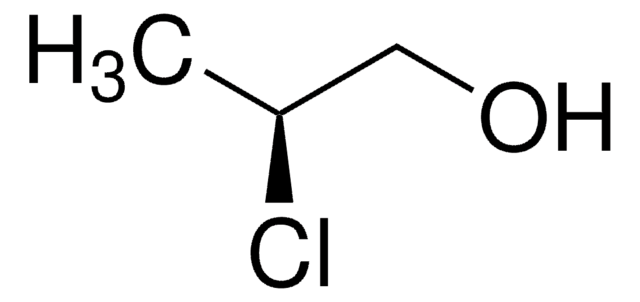모든 사진(1)
About This Item
Linear Formula:
CH3CH(OH)CH2Cl+CH3CHClCH2OH
CAS Number:
Molecular Weight:
94.54
Beilstein:
773653
EC Number:
MDL number:
UNSPSC 코드:
12352100
PubChem Substance ID:
NACRES:
NA.22
추천 제품
일반 설명
1-Chloro-2-propanol is formed as an intermediate during the degradation of meso-bis-(1-chloro-2-propyl)ether by Rhodococcus sp. strain DTB.
애플리케이션
1-Chloro-2-propanol has been used as:
- chemical intermediate for the manufacture of propylene oxide, a starting material for production of polyurethane polyols and propylene glycol
- as α,β-halohydrin standard during the enzymatic synthesis of α,β-halohydrins from gaseous alkenes
신호어
Danger
유해 및 위험 성명서
Hazard Classifications
Acute Tox. 3 Inhalation - Acute Tox. 3 Oral - Eye Irrit. 2 - Flam. Liq. 3 - Skin Irrit. 2 - STOT SE 3
표적 기관
Respiratory system
Storage Class Code
3 - Flammable liquids
WGK
WGK 3
Flash Point (°F)
125.6 °F - closed cup
Flash Point (°C)
52 °C - closed cup
개인 보호 장비
Eyeshields, Faceshields, Gloves, type ABEK (EN14387) respirator filter
이미 열람한 고객
Leif-Alexander Garbe et al.
FEMS microbiology ecology, 55(1), 113-121 (2006-01-20)
Rhodococcus sp. strain DTB (DSM 44534) was grown on a mixture of (R,R)-, (S,S)- and meso-bis-(1-chloro-2-propyl) ether (BCPE) as the sole source of carbon and energy. During BCPE degradation 1'-chloro-2'-propyl-3-chloro-2-prop-1-enyl-ether (DVE), 1-chloro-2-propanol and chloroacetone intermediates were formed. The BCPE or
J Geigert et al.
Applied and environmental microbiology, 45(2), 366-374 (1983-02-01)
The enzymatic synthesis of alpha,beta-halohydrins from gaseous alkenes is described. The enzymatic reaction required an alkene, a halide ion, dilute hydrogen peroxide, and a haloperoxidase enzyme. A wide range of gaseous alkenes were suitable for this reaction, including those containing
Propylene chlorohydrins: toxicology, metabolism, and environmental fate.
R S Yang
Reviews of environmental contamination and toxicology, 99, 47-59 (1987-01-01)
J A Bond et al.
Toxicology and applied pharmacology, 95(3), 444-455 (1988-09-30)
Propylene chlorohydrins, of which 1-chloro-2-propanol (1-CP) is a constituent, used as intermediates in the manufacture of propylene oxide and have been identified as potential air pollutants. The objective of these studies was to determine whether changes in the inhaled exposure
Reproductive toxicology. 1-Chloro-2-propanol.
Environmental health perspectives, 105 Suppl 1, 291-292 (1997-02-01)
자사의 과학자팀은 생명 과학, 재료 과학, 화학 합성, 크로마토그래피, 분석 및 기타 많은 영역을 포함한 모든 과학 분야에 경험이 있습니다..
고객지원팀으로 연락바랍니다.













